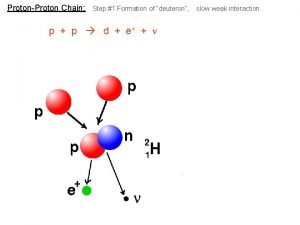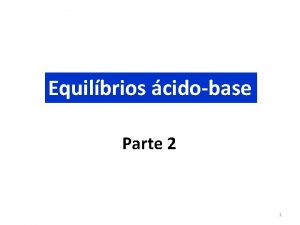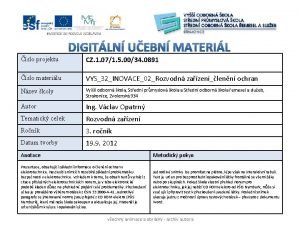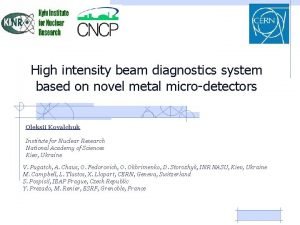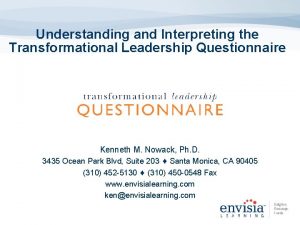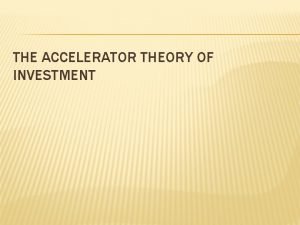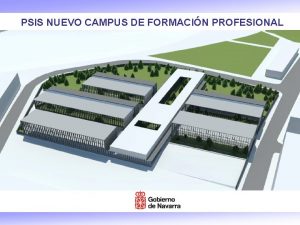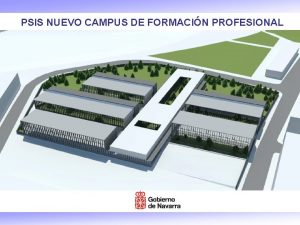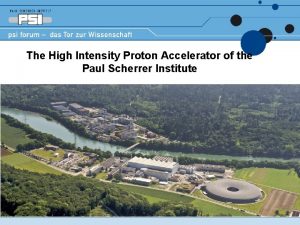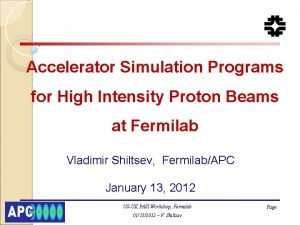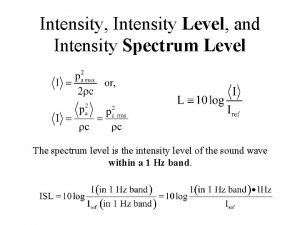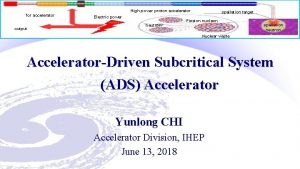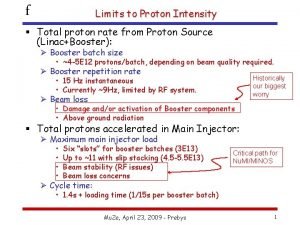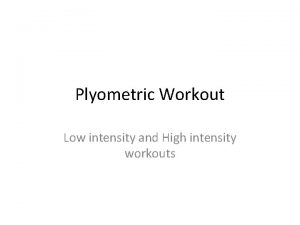PSIs high intensity proton accelerator an overview Mike







![concept of target beamline [side view] secondary shielding platform for electronics, pumps etc. 4 concept of target beamline [side view] secondary shielding platform for electronics, pumps etc. 4](https://slidetodoc.com/presentation_image_h2/8fdd8e93cb180f999d90d4654ca470bd/image-8.jpg)





- Slides: 13

PSI’s high intensity proton accelerator – an overview Mike Seidel, PSI

Accelerator Facilities at PSI High Intensity Proton Accelerator 0. 59 Ge. V, 2. 2 m. A Neutron Source and Instruments p-Therapie 250 Me. V, <1 A central controlroom µSR, particle physics Swiss Light Source 2. 4 Ge. V, 400 m. A XFEL Injector 250 Me. V

Overview HIPA Injector II Cyclotron 72 Me. V Cockcroft Walton Ring Cyclotron 590 Me. V 2. 2 m. A /1. 3 MW / secondary beamlines target M (d = 5 mm) target E (d = 40 mm) 1. 5 m. A /0. 9 MW CW operation UCN source SINQ spallation source proton therapie center [250 Me. V sc. cyclotron] dimensions: 120 x 220 m 2 SINQ instruments M. Seidel, 9/2013

PSI Ring - a separated sector cyclotron CW acceleration losses: ≈2· 10 -4 high RF efficiency up to 400 k. W power transfer per resonator possible • concept works up to 1 Ge. V • • Electrostatic Deflector beam profile at extraction: dynamic range: factor 2. 000 in particle density extraction septum d= 50µm 50 MHz resonator 150 MHz (3 rd harm) resonator

operational statistics 1. 4 MW (several technical improvements) 93% (all time high) availability current

PSI-HIPA Powerflow Efficiency of RF: 32% 0. 90 (AC/DC) 0. 64 (DC/RF) 0. 55 (RF/Beam) public grid ca. 10 MW RF Systems 4. 1 MW Beam on targets 1. 3 MW n: per beamline: 13 s-1@ 10 e. V ≈ 20µW 10 neutrons +: per beamline muons 5· 108 s-1 @ 30 Me. V/c ≈ 300µW RF efficiency is high at HIPA Magnets 2. 6 MW conversion to secondary particles improvement potential aux. Systems Instruments 3. 3 MW cryogenics heat to river, to air

high beam power: essential auxilliary capabilities activation in cyclotron peak: ≈10 m. Sv/h activated collimator in hot cell [500 Sv/h = 5 E 4 rem/h @ entrance] exchange flask for meson production target
![concept of target beamline side view secondary shielding platform for electronics pumps etc 4 concept of target beamline [side view] secondary shielding platform for electronics, pumps etc. 4](https://slidetodoc.com/presentation_image_h2/8fdd8e93cb180f999d90d4654ca470bd/image-8.jpg)
concept of target beamline [side view] secondary shielding platform for electronics, pumps etc. 4 cm Target collimators BEAM DUMP primary shielding Iron ! vacuum chimneys for inserts, pumping connections

Meson Production Target TARGET CONE Mean diameter: 450 mm Graphite density: 1. 8 g/cm 3 Operating Temp. : 1700 K Irrad. damage rate: 0. 1 dpa/Ah Rotation Speed: 1 Turn/s Target thickness: 40 mm 7 g/cm 2 Beam loss: 12 % Power deposit. : 20 k. W/m. A Muon Transport Channel E 4 target, d=40 mm solenoids Muon Rate: 4. 6 E 8 +/sec @ p=29. 8 Me. V/c quadrupoles T. Prokscha et al NIM-A (2008)

HIPA ongoing improvements – injector cyclotron today: 2 150 MHz 50 MHz 150 MHz Today in a different place after completion: 50 MHz 4 measure: exchange of 150 MHz third harmonic resonators against 50 MHz fundamental mode resonators goal: more reliable operation with unified components (tubes); lower losses, thus higher current possible 50 MHz new 50 MHz resonator: (first resonator delivered 2011) [PSI: W. Tron, M. Schneider, M. Bopp, SDMS/france]

SINQ Upgrade – Source, Neutron Optics and Instruments 2 Source-to-Detector Optimization SINX [U. Filges, M. Wohlmuther, W. Wagner, M. Kenzelmann, Ch. Rüegg] Upgrade of moderators to gain neutron flux Targets: Increase detection rate of useful neutrons by factor 10 -100, reduce measureable sample mass by same factor Benchmark: Signal/noise of leading continuous neutron sources (x 10 peak flux) Source: - optimize moderators, H 2 O scatterer - increase dynamic range of thermal diffraction & spectroscopy Guide system: - novel guide technology SINQ moderator tank Global optimization from source to detector - development of focusing devices - technology transfer to Swiss industry advanced neutron guides Instruments: - global optimization of signal-to-noise Detectors: 25. Januar 2022 detector - wide-angle analyzer systems - concept development with ESS source - increased area - need new approach beyond 3 He Gain signal/noise by factor 10 -100 page 11

Potential option for future: Hi. MB = “High Intensity Muon Beam” [PR. Kettle et al] at 25 cm distance 5· 1010 µ+/s/m. A expected Idea: extract Muons from spallation target window; ongoing study Principle: • “Guiding field” solenoid – capture downward µs & transport to “focussing” solenoid • “Focussing” solenoid – replacement of defocussing quadrupole doublet QHJ 31/32 act as focus for upward protons and a transport solenoid for downward muons • • • “Fan-coupling” vacuum chamber – modification of AHO upper-part of vacuum chamber to allow extraction in the fringe-field of the AHO “Collection” solenoid for capture of momentum dispersed muons from AHO [M. Wohlmuther] Guiding solenoid Focussing solenoid Fan-coupling Vac chamber collection solenoid p Conventional Dipole & Quad Channel Conventional Dipole/Quadrupole channel – transportation of muons through cellar & to an experimental hall external to the SINQ hall Peter-Raymond Kettle Hi. MB Kickoff Meeting Aug. 2013

HIPA - Summary • With 1. 3 MW @ 0. 59 Ge. V PSI‘s HIPA operates at the forefront of high intensity accelerators • HIPA runs reliably (≥ 90%) with high electrical efficiency (RF: 32%) • ongoing improvement of accelerator for reliable operation; upgrade potential exists up to 1. 8 MW • ongoing studies to better exploit the generation of secondary particles – Muons and Neutrons
 Proton proton chain
Proton proton chain Proton proton chain
Proton proton chain Proton proton chain
Proton proton chain Psis level with s2
Psis level with s2 Psis bank
Psis bank Antocianinas
Antocianinas Pšis cd rom elektro
Pšis cd rom elektro High intensity flag football
High intensity flag football Paul jennings high intensity network
Paul jennings high intensity network High intensity x-ray beam machine
High intensity x-ray beam machine Transformational leadership inventory
Transformational leadership inventory Limitations of accelerator theory of investment
Limitations of accelerator theory of investment Biztalk accelerator for swift
Biztalk accelerator for swift Netbackup accelerator track log
Netbackup accelerator track log

